Download our free Monitoring Fundamentals Tutorial.
An introduction to Monitoring Fundamentals strictly from the perspective of telecom network alarm management.
1-800-693-0351
Have a specific question? Ask our team of expert engineers and get a specific answer!
Sign up for the next DPS Factory Training!

Whether you're new to our equipment or you've used it for years, DPS factory training is the best way to get more from your monitoring.
Reserve Your Seat TodayYou likely still have a large investment in TL1, even though it's a legacy protocol. Your valuable gear, especially SONET and legacy gear, depends on your TL1 knowledge.
This Essential TL1 Guide provides basic info in a quick summary format, allowing you to spend your valuable time managing revenue-generating gear.
TL1 is a one of the most widely used telecom network management protocols. Although it is considered today to be a legacy protocol, a TL1 is still an important tool in the monitoring field because of its popularity among SONET, legacy, and other network elements.
This doesn't mean that you have to be a TL1 expert, but you must have a core working knowledge of the protocol to know what you can expect from TL1 telemetry reporting. And if your staff is telling you what can and can't be done with your TL1 monitoring system, you must be able to assess their accuracy.
This white paper is not a complete reference guide to TL1 protocol. Instead, it is a guide to key basics, providing the information you need in a quick format.
Transaction Language 1 (TL1) is a set of ASCII-based "messages". These messages allow a human user or an Operations Support System (OSS) to manage a network object (NE) and its resources.
A Standardized Protocol.
Bellcore developed TL1 in 1984 as a standard (MML) man-machine language to manage network elements. Before the development of TL1, most vendors designed gear around their own protocols. These protocols caused headaches for staff, programmers, and support technicians. Having a lot of protocols means more training, more support issues, and more screens to monitor.
With the creation of TL1, Bellcore hoped to introduce a single, open protocol for managing network elements. It was to replace the diverse protocols used by different vendors. A Man-Machine Language.
In addition to being open, TL1 is powerful because it bridges the gap between human users and network gear. It is structured enough to be parsed by machines, but also easy enough to be read by human staff. Since special decoders or debuggers are not needed, TL1 is a command line interface choice for equipment manufacturers. TL1 messages are also embedded with the database info required to interpret the meaning of an alarm.
How Knowing TL1 Will Help You.
TL1 is a multi-vendor and multi-technology protocol with management support. There's a very good chance that TL1 protocol plays a large role in your network. A solid foundation of TL1 knowledge allows you to do your job better. With this white paper, you're just a few pages away from the core knowing you need.
Is TL1 Easy to Understand?
TL1 is a set of ASCII-based instructions, or "messages". Because TL1 is text-based, you won't be scared by a jumble of code. This makes the learning curve for basic TL1 much shorter than with other protocols.
This doesn't mean, however, that you won't need a basic intro to TL1 basics. You must learn the basics before you can read, know, and write TL1 commands. TL1 message formats are very well defined and documented, and you can learn about the most common used commands in this guide.
3 Benefits Shared by TL1 and SNMP.
TL1 is a spiritual precursor to SNMP. Both were intended to be open standards and comprehensive languages. TL1 and SNMP protocols share the following three benefits:
Although there is a wide range of standard TL1 messages, four types comprise the majority of TL1 communication:
The DPS TL1 MUX-8 combines eight incoming TL1 streams into a single stream of data, allowing you to connect 8 physical ports to a single port on your TL1 master. This prevents simultaneous TL1 messages from "colliding" and becoming unreadable.
The TL1 MUX-8 watches for the semicolon terminator at the end of each TL1 message. If the single stream is currently available, the message is forwarded to your TL1 master instantly. If the single stream is busy sending messages from another port, any other simultaneous messages are stored in the 256K buffer. Stored messages are sent to your master, in the order received by the MUX-8, at the next available opportunity.
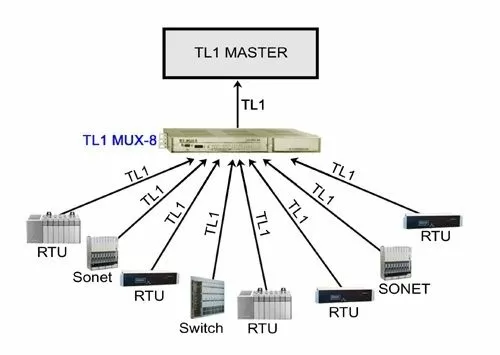
The Semicolon - Terminator. - ;
A semicolon signifies the end of a TL1 message.
The Colon - Separator. - :
Colons are used to separate the data "fields" in a TL1 message.
The Comma - Divider and Placeholder. - ,
Commas are used to divide message arguments and to hold the place of omitted arguments.
Hypothetical arguments A through E must be separated by commas. - :A,B,C,D,E;
Arguments may simply be omitted from the end. - :A,B;
Any gaps in the arguments require commas used as placeholders. - :,B,,,E;

Learn network alarm monitoring in-depth in a totally practical hands-on class. The DPS Telecom Factory Training Event will show you how to make your alarm monitoring easier and more effective. You'll learn SNMP alarm monitoring, ASCII alarm processing (a tool for parsing TL1 messages), derived alarms and controls, and how to configure automatic email and pager alerts. DPS training is the easiest way to learn alarm monitoring, taught by technicians who have installed hundreds of successful alarm monitoring
deployments.
"DPS Factory Training is a big help in not feeling intimidated by your network monitoring system. It's excellent - presented in the right way and tailored to the needs of the class."
- Bill Speck, 3 Rivers Telephone
"ASCII and TL1 commands... [were] presented very well, making the introduction to a new language enjoyable!"
- Dewayne Hamilton, Level 3 Communications
"[DPS Factory Training] really was the best training class I've been to in my telecom career."
- Mary Steffen, National Grid
For dates and registration information, call 1-800-693-3314 today or go to www.dpstelecom.com/training .
Although TL1 messages may look intimidating to new users, commonly used messages include several clearly defined elements that are separated by colons:
verb [-modifier [-modifier]]::TID:AID:CTAG:generalblock;
The first section of this message is structured in the following way:
verb [-modifier [-modifier]]:
Verb.
The verb refers to the type of action to be taken by the network object (in case of a command message) or the type of event that has occurred in the object (in case of an autonomous message).
(Ex. "ACT","RTRV")
Modifiers.
When they are used, Modifier 1 and Modifier 2 are used to identify and describe the object in the network object that the message will act on. Modifiers commonly refer to gear type.
(Ex. "RTRV-ALM-ALL","RTRV-ALM-T1")
The second part of the message, known as the "staging block", identifies the exact resource in the network object that will be acted on by the command. The staging block is constructed in the following format:
:TID:AID:CTAG:generalblock:
The Target Identifier (TID).
Every TL1 device is assigned a Target Identifier or (TID), which uniquely defines that device. The (TID) is the first command in the staging block sequence. The TID is subject to the following rules:
The Access Identifier (AID).
The Access identifier (AID) is found after the TID. It contains one or more simple or compound parameters. The parameters identify a single entity within the associated target object to be acted upon by the input message. In other words, the TID defines a network object (Switch Bay 1), and the AID defines the single segment (Shelf 3, Card 4) of that network object. The AID is often the field that uniquely identifies the alarm.
The Correlation Tag (CTAG).
A correlation tag (CTAG) is used to tie in a response or an acknowledgement to an earlier input message. When a response message is sent, it uses the same CTAG to indicate the command to which it is responding. It is, therefore, the user's responsibility to ensure that CTAGs are unique for each message. A replicated CTAG will not cause an error directly, but it will create uncertainty when responses are received with duplicate CTAGs. CTAGs are also used as serial numbers for autonomous alarm messages. If a number in the sequence is skipped (ex. 0001,0002,0003,0005), the user can see that an autonomous message was missed and send a "retrieve all alarms" command.
The General Block.
The General block holds the information of the message. It also denotes how its information will be used by the NE. Certain types of large network elements that engage in switching may make an extension to the basic TL1 message. The general block is required for commands that have a payload and varies depending on the command. The General Block can also be used to specify delayed actions. To accomplish this functionality, the general block must contain an order number, date, and time for automatic execution. The delayed action feature of TL1 is helpful for busy staff who must perform service maintenance or run performance analysis. You may schedule actions that will be stored in a remote buffer and executed at a single date and time.
Determining your alarm monitoring needs can be tough. If you've got a busy job with a lot of demands, you don't have a lot time to grade alarm systems and survey your remote sites.
So why not get help from experts you can trust? DPS Telecom will help you survey your remote sites step-by step, making sure you don't miss any opportunities to make your network monitoring simpler, more effective - and easier on your budget.
A DPS expert consultant can help your figure out what alarm system will most effectively meet your needs without overloading your budget. Our goal is to help you maximize your return on investment while minimizing your expenditure - without pressuring you to buy a particular system.
There's no hard-sell sales tactics. No harassing sales calls. No pressure to buy. We won't discuss single gear options until we've helped you plan the right monitoring strategy for your network.

Autonomous Messages.
Autonomous messages, the most frequently used TL1 response type, are output messages sent by the NEs to report alarms, performance data, configuration changes, or condition changes. This means that alarms are sent immediately, instead of waiting until someone requests a status update. In this way, autnomous messages are the TL1 equivalent of the SNMP trap. In addition to receiving autnomous alert of alarms, TL1 staff can schedule messages that periodically report performance data values.
Sample Autonomous Message #1 (Critical Alarm):

Sample Autonomous Message #2 (Alarm Clear):

As you can see, this message is almost identical to the original Autonomous Alarm Message, but with a slight difference: The code for Critical Alarm ("CR") has replaced by the code for Clear ("CL"). This indicates that the alarm condition described in the previous messsage has been cleared.
Command Messages.
TL1 commands request an action to be executed by the recipient of the message.
Sample Command #1 (Login to Network Element with "Activate" Command):

In this example, the UID is a username, and the PID is a password. They will be compared against the receiving element's administrator list to determine the success of this login attempt. It's also important to remember that some NEs will send you no response at all until you have logged in successfully. This is a security measure to prevent evil users from discovering that the NE is present at all. NOTE: Some TL1 NE's do not support any security, do not require a login, and do not support the "ACT-USER" command.
NOTE: The CANC-USER command is used to log off of a TL1 network object. Remember that some NE's will automatically log you off after a certain period of inactivity.
TL1 commands request an action to be executed by the recipient of the message.
Sample Command #1 (Login to Network Element with "Activate" Command):

In this example, the UID is a username, and the PID is a password. They will be compared against the receiving element's administrator list to determine the success of this login attempt. It's also important to remember that some NEs will send you no response at all until you have logged in successfully. This is a security measure to prevent evil users from discovering that the NE is present at all. NOTE: Some TL1 NE's do not support any security, do not require a login, and do not support the "ACT-USER" command.
NOTE: The CANC-USER command is used to log off of a TL1 network object. Remember that some NE's will automatically log you off after a certain period of inactivity.
The response message (or "output message") is a reply sent by the NE in response to an input message. The response comes upon the completion of the task requested by the TL1 input message, and it states whether or not the requested task was completed successfully.
Sample Response (Response to User Login Attempt):

An acknowledgement message is a special reply sent by the NE in connection with a delayed command. This special response is issued after the receipt of the command. It indicates the status of the request:
An acknowledgement message begins with a two-letter response code. It could be:
IP - "In Progress" - Sent if the NE cannot execute a request within 2 seconds.
PF - "Printout Follows" - Command execution is in progress and a response will be sent upon completion.
OK - "Current status is OK" - Command has been executed successfully.
NA - "No Acknowledgment" - Execution status is unknown (an error).
NG - "No Good" - Valid command, but cannot be executed due to a parameters issue (an error).
RL - "Repeat Later" - System resources are not currently available to process your command.
Immediately following this two-letter response code, a CTAG matches the acknowledgement message with its associated command message.
Sample Acknowledgement (Delayed Command Execution Notification):
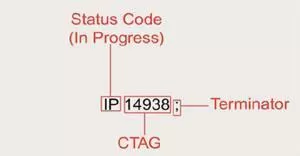
If a TL1 device encounters an error, it will respond directly with an error message containing four standard characters. Most monitoring systems support the same distinct code system. These codes tell you where you need to look to correct your command (TID, AID, etc.).
Sample Error Message:
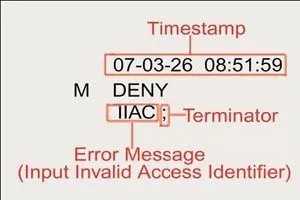
Other Four-Letter Error Codes:
ICNV - Input, Command Not Valid.
IITA - Input, Invalid Target Identifier (TID).
IIAC - Input, Invalid Access Identifier (AID).
IDNV - Input, Data Not Valid.
INUP - Input, Non-null Unimplemented.
IISP - Input, Invalid Syntax or Punctuation.
PIFC - Privilege, Illegal Field Code.
Human staff can interact directly with TL1 gear through a command line interface via Telnet or serial connection. Commands may be typed manually to query and control network elements.
Entering TL1 commands manually via command line must be done carefully, as any mistake will result in an error. This can be very frustrating, because the message must be retyped from scratch. If your NEs have special editing capabilities, you might be able to scroll back to your previous message and correct your mistake, but this is not a core part of TL1.
On some network elements, an echo feature is available to help you minimize retyping. As you type, your characters will be "echoed" back to you by the NE. You'll be able to see what you've typed as you compose your TL1 messages. Be sure to activate this option carefully, however. If a lot of NE's can "see" your keystrokes, you may get a lot of echos ("AAACCCTTT---UUUSSSEEERRR").
When 2 machines are talking, you'll want to turn off any echo options, because machines always know what they typed. Echo can also cause confusion for alarm masters when it's left on.
Another potential solution is to activate a "local echo" option in your terminal software. This will make commands you type appear within your terminal. Should you make a mistake, you can most likely copy your original message, correct the error, then resubmit the command without retyping it completely.

In my experience, clients who think hard about cost justification have a more important concern than just price. They want to make sure that they're not spending their company's money on a system that doesn't work as advertised.
That's smart. You have to be careful when working with gear vendors, especially on protocol mediation projects. Most vendors can't support all your legacy gear, and they don't have the development capabilities to make integration work.
Some vendors will charge you large NRE (non-refundable engineering) fees up front for custom work. Also, they give no guarantee that the resulting product will meet your performance requirements.
Personally, I think that's a lousy way to do business. I give all my clients a 30-day guarantee: If my product doesn't completely satisfy you, return it for a full refund. If I can't give you a solution, I don't want your money. If I'm doing custom work for you, I don't expect you to pay for it until I've proven that it works to your satisfaction.
Very few vendors will make that guarantee. But you need to demand the best level of service from your vendor to ensure that your implementation is 100% successful.
Unlike polled protocols, TL1 sends autonomous messages to your master. While this reduces network traffic, it also means that you do not automatically receive alert that a network object is down. If you're not receiving autonomous alarms from a device, you don't know for sure whether the situation is normal or your TL1 device has failed. You must send a command to act as a "ping". If you receive a reply, you will know that your network object is online.
In TL1, The RTRV-HDR ("Retrieve Header") command is commonly used to confirm a network object is online. Both the command and the response are simple, but they achieve the intended reason of testing device status.
RTRV-HDR Command Format:
![]()
Example RTRV-HDR Command:
![]()
Example RTRV-HDR Response:

You must insert the TID of the device you are pinging and specify a CTAG. If you receive a response with the same TID and CTAG you used, you have confirmed that the TL1 device you pinged is online.
While manual RTRV-HDR commands can be useful in some situations, a good alarm master can be programmed to send RTRV-HDR commands to devices at regular intervals to ensure that failures will be detected within a reasonable amount of time. RTRV-HDR can also be used check the NE's current time-of-day and to avoid being logged off due to inactivity.
The "Retrieve Alarms" command is commonly used to review an NE's current standing alarms. It's also useful if you see a gap in the CTAG sequence of autonomous messages. This almost always means that you've missed an alarm message, so it's important to request a full alarm listing so you can see what's happening with your network object. One handy feature of RTRV-ALM is the availability of extra modifiers that limit the scope of your alarms (Ex. RTRV-ALM-ALL will return all standing alarms, white RTRV-ALM-T1 will return only standing T1 alarms). This is similar to a database query and has the added advantage of limiting the bandwidth consumed by the response message. You can also restrict the alarm list by adding other criteria, as shown in the example below:
Example (Retrieve all vital alarms ("CR") from the "FRESNO_NODE3" network element):.
![]()
Example (Response to RTRV-ALM-ALL, vital alarms only command):
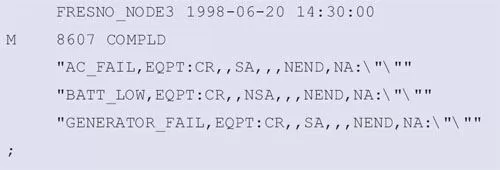
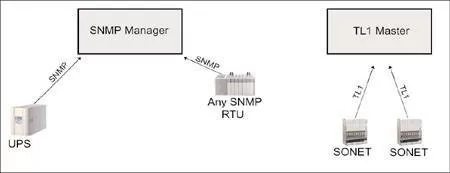
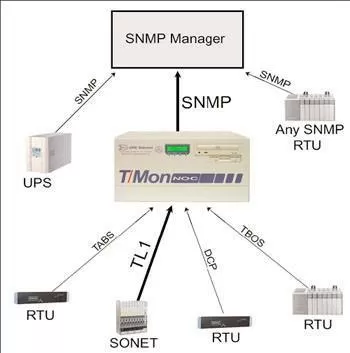
Are you running a TL1 master sideby-side with your SNMP manager? That's two screens to watch, which increases the chance that you'll miss an alarm. You have to train and pay a lot of staff just to achieve basic alarm visibility.
T/Mon NOC collects alarms from over 25 protocols, including TL1, and forwards them as SNMP traps to your SNMP manager. Now you can see you entire network status from just one screen.
You also get all of the other benefits of T/Mon, including paging and email alerts, derived alarms and controls, text messages, trouble logs, and more. To learn more about T/Mon NOC, visit http://www.dpstelecom.com/tmon
A rapidly growing, technologically advanced network. A mix of diverse gear. Remote sites spread across three provinces.

Canadian triple-play provider EastLink is successfully managing the network of the future with help of T/Mon NOC and the NetGuardian 832A.
Based in Halifax, Nova Scotia, EastLink is considered a market leader and innovator for its successful launch of telephone service over a cable network in the late 1990s. The company saw an opportunity to expand and enter a new market when the Canadian government deregulated telecom, allowing local competition.
In 1999, with a strong entrepreneurial spirit at its back, EastLink became the first Canadian cable company to successfully expand into the local residential telephone service. Service was later launched to business customers in 2001.
Since then, EastLink has been growing offering bundled telephone service, high-speed Internet access and digital cable at competitive prices in a rapidly expanding service area.
"We were the first cable company in Canada to launch residential telephone service and bring competition to the local market. That's an achievement for a company that at the time employed just over 200 employees," said Jim Bower, EastLink's telecom actions manager. "Then we were the first to introduce communications and entertainment bundles. Six years have passed and cable and telephone companies continue to follow our lead."
Leveraging the existing network
EastLink has a terrific advantage in delivering triple-play - the company leverages its existing cable TV infrastructure to deliver all three services. It provides voice telephony over a hybrid fiber-coaxial network using an Arris Cornerstone cable telephony system.
From the customers' point of view, phone service over EastLink's coax looks and feels no different than service from a traditional provider - even the standard phone jack looks the same. "The secret to our success is that we've been able to deliver a phone service that meets our customers' needs, while at the same time providing them with great value and choice. " said Bower.
Managing a growing network is an alarm monitoring challenge.
Rapid growth, new customers and leveraging new use from existing network gear are all strengths - but they also add up to a tremendous network management challenge. Besides the growing number of network sites to manage, EastLink operates a diverse mix of gear, each of which has its own monitoring and management interface.
"We have an array of different diagnostics and alerts from our Operational Support Systems (OSS)," said Bower."While we know there are a number of things happening on our network, visually it was often difficult to locate the exact problem.
Despite all those a lot of systems, EastLink still needed an environmental monitoring system and that is why it turned to DPS Telecom. "Until we starting using the NetGuardian, we didn't have consistent environmental telemetry at our head-end sites. We have approximately 15 main sites and 25 to 30 smaller sites, and we weren't always aware of some small and larger issues like: Is the door open? Is it too hot? Is there power?" Bower said.
Getting that environmental information is crucial, because EastLink's remote sites are scattered throughout the Maritimes. Some of the sites are located six hours away from EastLink's Halifax headquarters, posing significant challenges if or when a problem arises.
That is why tackling the monitoring challenge with the NetGuardian and T/Mon NOC was so important. EastLink first came to DPS Telecom to add environmental monitoring capability. From that point on, they started installing NetGuardian 832A remote telemetry units at their head sites to monitor power supplies, temperature and door alarms. Working with the NetGuardian led EastLink to see the advantages of the T/Mon NOC Remote Alarm Monitoring System.
"At first we were using an SNMP manager to pick up SNMP traps from the NetGuardians," said Bower."SNMP managers have an extensive programming background and in order to know the information, you also needed to have this background. We needed a system that could be understood by someone with a basic telephony background."
Bower then compared the awkwardness of the SNMP manager's presentation with the ease-of-use and presentation capabilities of T/Mon NOC.
"Every year I've been to SUPERCOMM, a major telecommunication conference, I've always stopped by the DPS booth and looked at T/Mon. I've seen demos and Rick Dodd, DPS Director of Sales, demonstrated a live T/Mon demo over the Web. We were impressed with T/Mon - someone with a basic telecommunications background could use the technology," Bower said.
According to EastLink NOC supervisor Derrick Stennett, T/Mon NOC's single and detailed alarm information is helping the company manage problems better and faster.
"The most important way we've been able to use T/Mon is to list single information in the text messages for each alarm. For example, in the event of a smoke alarm, I can see a single number to call to escalate the alarm. I also see a contact for security company to follow up on the site. I also have the single location of the site in case 911 needs to be called. The information's right in front of me, resulting on overall increased efficiency and a significantly shorter repair time," Stennett said.
By consolidating alarm information in one place, T/Mon also lowers staffing costs, according to Bower. "We have a 24-hour staffed Network Operating Centre and with all we have to manage, we had to evaluate whether we add more resources or find a technology that can help us manage the network. With T/Mon, we hope to move towards a time when one employee can monitor the network and use just one screen as their first alert," Bower said.
T/Mon NOC's unified presentation - displaying all alarms from the entire network on one screen - is helping EastLink manage its diverse mix of gear. EastLink's Cornerstone gear reports to T/Mon NOC over TL1 protocol using T/Mon's ASCII Alarm Processor Software Module. Their DMS switch reports via ASCII messages, which are also parsed by T/Mon's ASCII Processor. NetGuardian 832A remote telemetry units collect environmental alarms at remote sites and report them to T/Mon NOC.
In the future, Bower and Stennett hope to use SNMP alarm reporting to tie even more gear to T/Mon NOC's integrated alarm presentation.
"We're trying to consolidate all alarms into T/Mon so, if I want to know what's happening on the network, I can look at one screen and. With a high degree of accuracy, I know it's been a quiet day with no alarms," said Stennett.
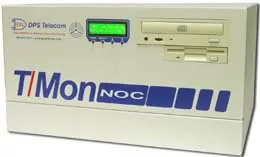
Sign up for a Web demo of T/Mon NOC
at www.dpstelecom.com/webdemo
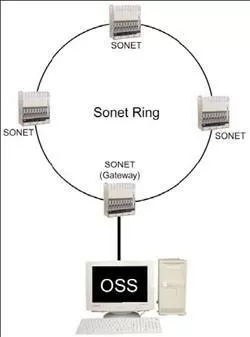
SONET devices are some of the most commonly deployed TL1 network elements today. The special architecture of a SONET ring offers added benefits for TL1 monitoring.
A SONET ring must be joined to the TL1 OSS through only one device on the ring (known as the "Gateway"). Whenever the gateway network object receives a TL1 message, it uses the TID to route the message to the appropriate network object.
In this way, you can reach all of the devices on a SONET ring by connecting to only one.
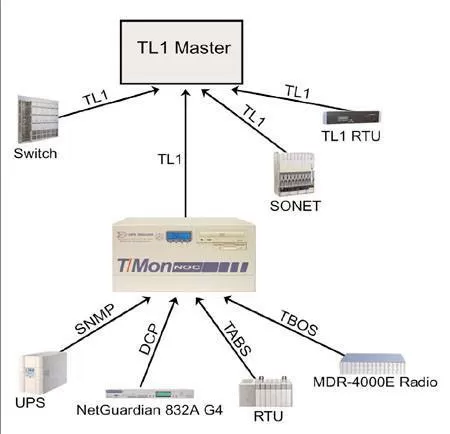
If you are primarily using a TL1 master, you know the difficulties of monitoring devices that talk in other protocols. To maintain adequate visibility, you have to run a lot of masters at the same time, which means more screens to watch, more interfaces to learn, and a significant risk that you'll miss a vital alarm.
T/Mon provides the solution, offering you the capability to collect alarms in over 25 protocols and mediate them to your existing master as TL1 messages. Alternatively, since T/Mon can also interpret TL1 messages from network elements, you have the option of replacing your TL1 master with T/Mon and using it as your top-level monitoring platform. To learn more about T/Mon LNX, visit here
For Additional Information
This guide provides an introduction to the basics of TL1 protocol. For extra information concerning TL1 please refer to the following Telcordia documents:
TL1 is a one of the most widely used telecom network management protocols. Although it is considered today to be a legacy protocol, a TL1 is still an important tool in the monitoring field. It still has popularity among SONET, legacy, and other network elements.
This doesn't mean that you have to be a TL1 expert, but you must have a core working knowledge of the protocol to know what you can expect from TL1 telemetry reporting. And if your staff is telling you what can and can't be done with your TL1 monitoring system, you must be able to assess their accuracy.
This white paper is not a complete reference guide to TL1 protocol. Instead, it is a guide to key basics, providing the information you need in a quick format.